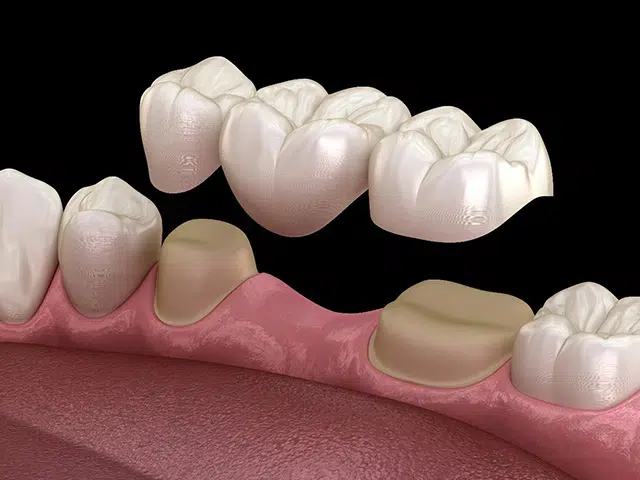2104 Old Spartanburg Rd Greer, SC 29650

Bridging Gaps, Restoring Smiles in Greer, SC
When a person experiences severe damage or loss of a tooth, it significantly impacts their quality of life. Beyond affecting their smile's aesthetics, they may endure challenges such as diminished self-esteem, discomfort while eating or speaking, and compromised oral health. If you find yourself in this situation, the compassionate dental professionals at Cove Dental Care are here to assist you. Through our affordable tooth replacement options, such as porcelain dental bridges, you can rejuvenate both the health and appearance of your smile within a welcoming and expertly managed environment. Before considering a consultation with Dr. Carraway and our proficient team in Greer, SC, here's all you need to understand about porcelain bridges.
What Is a Dental Bridge?
A dental bridge serves as a solution for replacing missing teeth, utilizing a fixed device comprised of artificial teeth supported by either dental crowns or implants. This restoration not only enhances functionality and aesthetics but also prevents adjacent teeth from shifting, thereby improving bite and speech. Various types of dental bridges exist, and the procedure usually entails two or more appointments, including tooth preparation, custom bridge fabrication, and final cementation.
Why Would I Need a Dental Bridge?
If you have one or more missing teeth, you might require a dental bridge. Missing teeth can lead to several issues, including:
Difficulty chewing and speaking:
Missing teeth can hinder your ability to chew food properly and articulate speech clearly.
Shifting of adjacent teeth:
When a tooth is missing, neighboring teeth may shift, leading to bite irregularities and complicating thorough teeth cleaning.
Gum disease and tooth decay:
Spaces between teeth can form pockets where bacteria accumulate, potentially leading to gum disease and tooth decay.
Changes in facial structure:
Loss of teeth can alter facial structure, potentially aging your appearance.
A dental bridge can aid in restoring both the function and aesthetics of your teeth, enhancing your bite and speech, and preventing neighboring teeth from shifting. Additionally, it assists in evenly distributing bite forces, mitigating further wear and tear on teeth.
Your dentist can evaluate your unique needs and oral health to ascertain if a dental bridge is the appropriate treatment for you.
The History of Dental Bridges
The saga of dental bridges traverses centuries, mirroring the evolution of dental care and the pursuit of reinstating oral function and aesthetics. From ancient civilizations to contemporary breakthroughs, dental bridges have been pivotal in addressing the voids caused by missing teeth. This narrative embarks on an expedition through the historical odyssey of dental bridges, elucidating their origins, progressions, and enduring importance in the realm of dentistry.
Ancient Beginnings
The origins of dental bridges can be dated back to ancient civilizations that acknowledged the significance of restoring dental function and aesthetics. Archaeological evidence indicates that the Etruscans, an ancient Italian civilization, were among the pioneers in experimenting with tooth replacement techniques. They utilized materials such as human or animal teeth secured by gold bands to fashion rudimentary dental bridges.
Egyptian Ingenuity
In ancient Egypt, the quest for dental reconstruction persisted. Archaeological findings suggest that Egyptians employed a range of materials for replacing teeth, including ivory, seashells, and even precious metals. These early endeavors laid the foundation for the idea of dental bridges, albeit in rudimentary forms compared to contemporary standards.
Advancements in Ancient Rome
The Roman Empire saw continued progress in dental care. Aulus Cornelius Celsus, a Roman physician, documented procedures for replacing lost teeth in his medical texts. These methods entailed affixing replacement teeth to neighboring ones using gold wire. Though these techniques may not have matched the sophistication of modern practices, they represented a notable advancement in tooth replacement methodologies.
A Renaissance of Knowledge
The Middle Ages saw modest advancements in dentistry, but the Renaissance era sparked a resurgence of curiosity in scientific inquiry. The groundbreaking contributions of Ambroise Paré, a French surgeon, played a significant role in the evolution of dental bridges. Paré's writings explored techniques for tooth extraction and the utilization of artificial teeth crafted from materials such as ivory.
Revolutionary 18th and 19th Centuries
During the 18th and 19th centuries, remarkable progressions unfolded in dental healthcare. Pierre Fauchard, recognized as the “Father of Modern Dentistry,” pioneered the notion of dental prosthetics, laying the groundwork for contemporary dental bridges. In the early 19th century, porcelain dentures and bridges gained prominence, largely due to the endeavors of Claudius Ash, a dentist based in London. These porcelain bridges provided enhanced aesthetics and longevity in contrast to earlier materials.
The Advent of Modern Dentistry
The late 19th and early 20th centuries ushered in a pivotal era in dentistry characterized by the emergence of novel materials and methodologies. The introduction of dental alloys and advancements in adhesive techniques enhanced the stability and aesthetic appeal of dental bridges. Innovations such as the casting technique and precision attachments further enhanced the precision and efficacy of crafting and positioning dental bridges.
Contemporary Innovations
The latter part of the 20th century witnessed notable technological progress in dentistry. The advent of dental implants transformed tooth replacement methods, presenting an alternative to conventional bridges. Dental implants introduced a stable base for individual crowns or bridges, reducing reliance on adjacent teeth for support.
Materials and Techniques
Contemporary dental bridges are tailored using diverse materials to accommodate the needs and preferences of patients. Porcelain-fused-to-metal (PFM) bridges blend the aesthetic appeal of porcelain with the robustness of metal, achieving a harmonious blend of appearance and strength. All-ceramic bridges provide a natural aesthetic without metal components, rendering them particularly favored for visible regions. Moreover, innovations in digital imaging and computer-aided design and manufacturing (CAD/CAM) have revolutionized the process of designing and producing customized bridges.
The Enduring Significance
Dental bridges remain highly important in restorative dentistry, providing an efficient means of replacing missing teeth, reinstating proper oral function, and improving aesthetics. Beyond facilitating comfortable chewing and speech, dental bridges play a vital role in preserving the alignment of neighboring teeth and averting bone loss in the jaw.
Conclusion
The evolution of dental bridges mirrors humanity's ongoing pursuit of innovation and enhancement in oral healthcare. Spanning from ancient civilizations to contemporary advancements, dental bridges have progressed alongside developments in materials, methodologies, and technology. Enduring as a testament to their importance, dental bridges persist as a fundamental component of the diverse range of restorative solutions accessible to patients. With each smile restored by a dental bridge, the legacy of this historical odyssey persists, influencing the landscape of dentistry by bridging gaps and revitalizing countless smiles.

